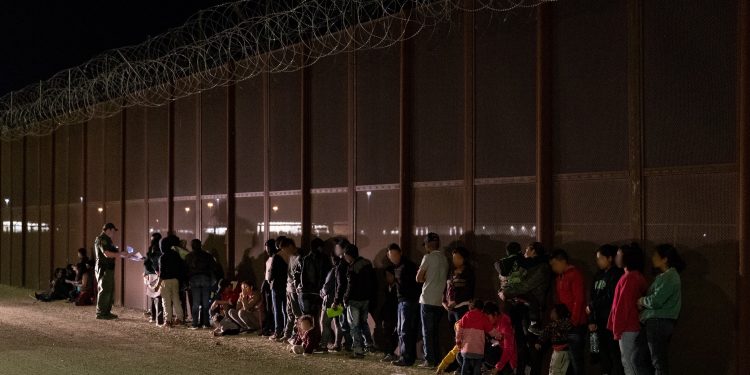Illegal immigration from India to the US, which has suddenly increased along the border with Mexico in the last two months, has come under the limelight following the death of an Indian man who fell while attempting to scale a border wall into Texas.
According to figures provided by the American government, the US Border Patrol apprehended 4,297 Indians crossing the border with Mexico in October and November, up from 1,426 in the same two months a year prior and 16,236 for the entire fiscal year that ended in September.
Indians have been detained by US officials more than twice as many since last year, both at the border and elsewhere.
According to Customs and Border Protection (CBP) figures, during the fiscal year 2021–22 that concluded in September, US authorities discovered 63,927 Indians who had entered the country illegally, a 109 per cent increase over the 30,662 they discovered the prior fiscal year.
The data showed that 13,655 illegal immigrants from India were apprehended in just the last two months, as opposed to 6,865 during the same two months in 2021. According to the government, the CBP only detained 19,883 Indians living illegally in the US during the 2019–20 fiscal year.
The phenomenon of illegal immigration to the US, which has been on the rise since President Joe Biden and Vice President Kamala Harris was elected and given the job of halting the flow of migrants from Latin America, is not just limited to immigrants from India.
Despite Harris’ claim that the border is secure, US authorities recorded 2.77 million encounters with foreign nationals living illegally in the country during the fiscal year ending in September. This is an increase of 41% from the 1.96 million encounters recorded during the previous period.
There were just 646,822 encounters in 2019–20. Even though the Supreme Court glibly opposed it, the Biden administration, which has been struggling to deal with the surge of those attempting to enter the US illegally at the southern border, gained a reprieve on Tuesday.
Under criticism from his Democratic Party’s left, Biden rescinded the restriction that had been put in place by his predecessor Donald Trump as a health precaution in response to the Covid-19 outbreak, which required returning Latin Americans from the majority of countries to Mexico when they are diagnosed.
The Supreme Court temporarily postponed the revocation until February after a coalition of Republican state leaders sued to stop it, preventing a predicted rush to the border. Due to Mexico’s refusal to accept them back, the law known as Title 42 is not applied to Indians or people from outside Latin America.
The data does not include people who entered the country legitimately but overstayed their visas, rendering their presence in the country illegally. The numbers of illegal migrants only include individuals who were apprehended by the CBP; many more would have been able to elude detection.
According to the Department of Homeland Security, there were 14,389 Indians suspected of overstaying in the 2019–20 fiscal year, the most recent time frame for which statistics are available, an increase from 13,203 the year before (DHS).
84 Indians have been detained in the past two months along Canada’s northern border, where a family of four Indians were discovered freezing to death in January just a dozen metres from the US border.
There were 237 Indians caught there during the US fiscal year that ended in September, compared to 42 during the previous year and 129 during the period before that.
Most people who are apprehended by US officials are released; typically, they are given the notice to appear before an immigration judge, but there is normally little to no follow-up and very few people are held.
There was no breakdown of how CBP-detained individuals were handled by nationality.
34,230 Indian asylum cases were pending before immigration courts as of last month, according to information from the Transactional Records Access Clearinghouse (TRAC), a database maintained by Syracuse University.
A court will require evidence before granting refuge, including threats related to domestic violence, sexual orientation, and fear of political or religious persecution. 1,337 Indians received asylum during the fiscal year 2019–20, the most recent time frame for which statistics are available from the Homeland Security Department, compared to 2,256 the year before.
According to the Department, 1,302 Indians requested asylum in 2017–18. There was no breakdown of the grounds for granting refuge. Punjabi speakers, who could be from India, Pakistan, or elsewhere, totalled 21,961 according to TRAC’s breakdown of the languages spoken by persons whose asylum claims are still pending.
There were 6,770 Hindi speakers, 6,315 Bengali speakers (from Bangladesh, India, or elsewhere), and 376 Tamil speakers (from Sri Lanka, India, or elsewhere). TRAC also listed 166 Telugu speakers, 32 Marathi speakers, and 222 Haryanvi speakers. In 2019–20 and 1,616 in 2018–19, respectively, 2,312 Indians were deported from the US, according to Immigration and Customs Enforcement.
Families died when Indians crossed the border, yet the majority of Indians detained by US authorities are single adults. 56,739 of those caught in 2021–2022 and 11,780 over the past two months were made up of them. 6,577 people entered as families in the previous fiscal year, while 1,736 did so in the previous two months.
On December 14, Brijkumar Yadav was scaling a border wall between San Diego and Mexico while holding his three-year-old kid. He then fell to his death. According to sources, his wife also fell, but she did so on US soil. She lived, and the child was reunited with her.
Later, on January 19, Jagdishkumar Patel, 39, his wife Vaishaliben, 37, and their children Vihangi, 11, and Dharmik, 3, were discovered frozen to death near the Canadian border.











